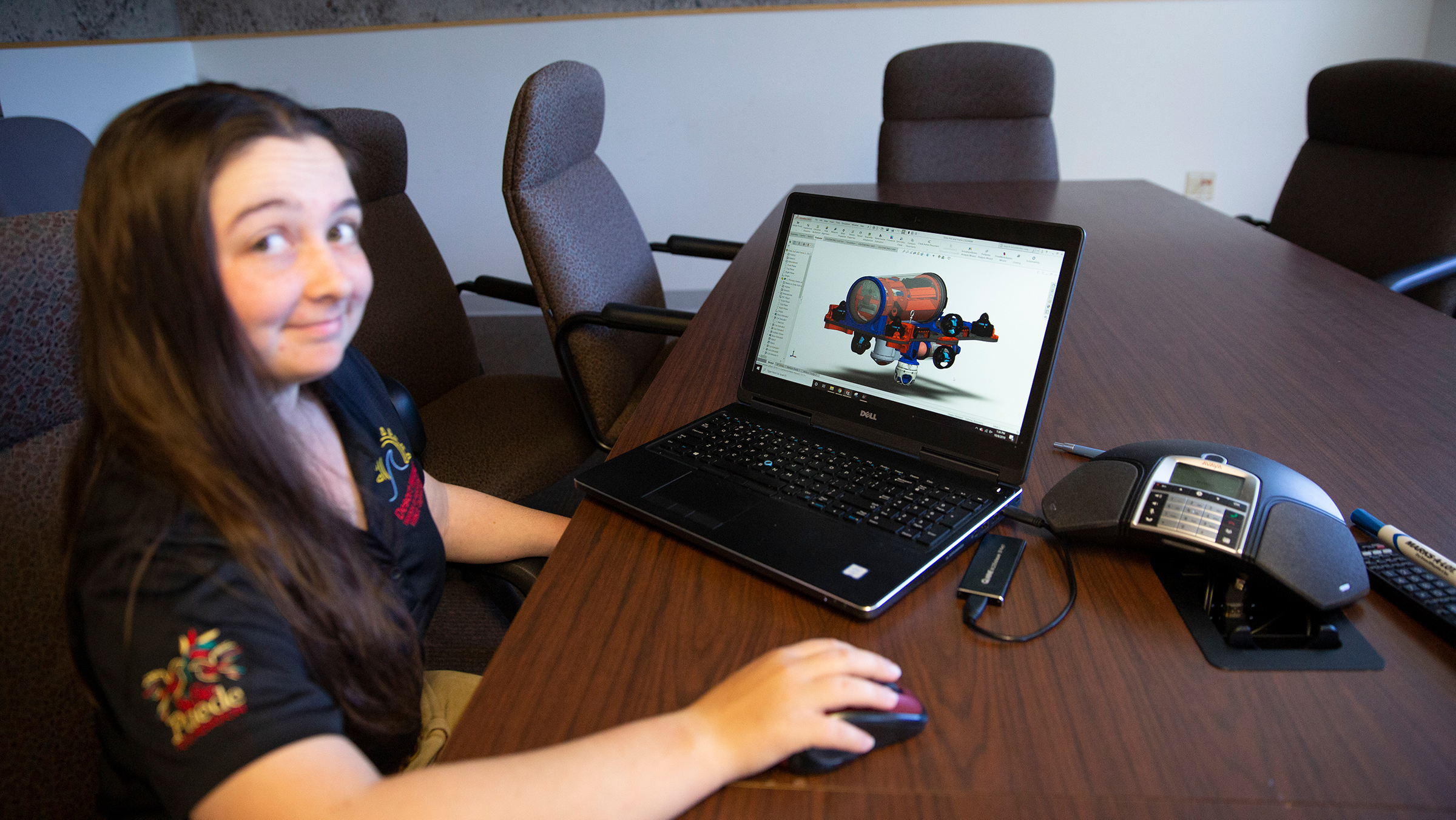ASU students place 2nd in the world at robotics competition

Desert WAVE team members pose with their first autonomous underwater vehicle during a team meeting last spring. In 2020, the team won second place overall in the 23rd International RoboSub Competition. Photo by Connor McKee/ASU
On Aug. 30, Desert WAVE members tuned into Zoom to attend the 23rd International RoboSub Competition. The Arizona State University and Si Se Puede Foundation all-female underwater robotics team was elated to place second overall, earning $3,800 in winnings. They virtually competed against 33 teams from nine countries and improved on their third-place win at last year’s competition.
The team also had top finishes in nearly all other categories — second place for their website, third place for their report and fourth place for their video.
“Whether they compete in an in-person competition or a virtual one, the students of Desert WAVE always bring their best,” said Daniel Frank, Desert WAVE faculty adviser and lecturer at The Polytechnic School, one of the six schools in the Ira A. Fulton Schools of Engineering at ASU. “I am very proud of their achievements over the past two years, and I’m excited to continue working with them to prepare for the next RoboSub competition.”
“When they announced Desert WAVE as winning second place overall, we could see each other’s excited expressions but couldn’t hear each other because we were all in muted Zoom squares,” said Laura Roty, a second-year engineering robotics major and member of Desert WAVE’s mechanical team. “Following the competition, we had a Zoom party to celebrate and congratulate each other.”
Changing courses
Due to the pandemic, this year’s RoboSub competition moved to a virtual format and submission requirements were modified. The competition organizer, RoboNation, prioritized participant safety and encouraged teams to share concepts, plans and parts if they were unable to complete their autonomous underwater vehicle.
To prepare for the competition, the group met multiple times per week on Zoom and maintained contact via phone calls, group messaging and their Slack channel to continue advancing their new autonomous underwater vehicle, Dragon. While socially distanced, team members conceptualized, designed and fabricated a marker dropper, torpedo launcher, pneumatic system and grabber designed to manipulate objects underwater. During this process, many team members also developed software to help with testing the robot once it’s safe to do so.
Newcomer Priscilla Ramirez, a third-year student double majoring in electrical systems engineering and human systems engineering, helped create the video and report.
“This was my first year on the team, so despite mainly functioning in a virtual format, I still felt the excitement from everyone else,” Ramirez said. “We all worked hard on the deliverables and continued fabrication with smiles on our faces and lots of enthusiasm even while socially distanced.”
The virtual competition
“Throughout the event, games of trivia were used as an icebreaker,” said Andrea Schoonover, a fourth-year software engineering student and project manager. “Even though the event was virtual, the trivia offered a way to collaborate and network — an aspect that we would’ve received in person and that made it fun.”
Both Schoonover and Roty agreed that winning second place was a full-circle feeling of knowing that their hard work was validated.
“A universal concern is, are we good enough?” Roty said. “The answer is yes and it was nice to see our hard work get recognized.”
Jessica Dirks, a fourth-year human systems engineering major and scrum master, uses the 3D computer-aided design software SolidWorks to share a conceptual view of last year’s autonomous underwater vehicle. Photo by Connor McKee/ASU
Next steps
Now that this year’s competition is over, Desert WAVE has begun recruiting new members and electing new officers with the goal of scaling up.
“We need more female programmers to join the team, especially programmers that have experience in autonomous vehicle applications,” said Faridodin “Fredi” Lajvardi, a Desert WAVE mentor and vice president for STEM initiatives at the Si Se Puede Foundation.
“After we celebrated our accomplishments, we immediately began discussing how we wanted to improve,” Roty said. “It reminded me how much heart this team has.”
Third-year mechanical systems engineering student Bridget Koehl says she’s already back at work.
“As soon as the computer-aided design of the computer hull is finished and printed, we will be able to start wiring,” she said. “Currently we are working one person at a time in a mentor’s garage to maintain social distancing.”
As for the group’s aspirations for next year’s competition, they are eager to see Dragon scorch the competition.
“We look forward to being the best in the world next year,” Lajvardi said.
Community outreach
The group also plans to continue community outreach initiatives to encourage young girls to pursue engineering.
“We are much more than a robotics team,” Schoonover said. “We are role models in the community and will continue to do outreach because it’s just as important as our technical mission.”
“I want to make an impact on girls who think they won’t feel comfortable in an engineering degree,” Roty said, “and show how fun and inspiring it actually is.”
Congratulations also go to Underwater Robotics at Arizona State who also competed at the International RoboSub Competition, confirming ASU as a leader in the field.
More Science and technology

New study uncovers another role for the cerebellum, offering clues about autism
There is a window of time, a critical period, during infancy and early childhood when the brain learns how to process information…

A cereal-box-sized space telescope heads for the stars
A small space telescope roughly the size of a family cereal box — having cleared its pre-shipment review by NASA last spring — is…

Hidden viruses thrive in desert wildlife
As the sun rises over the Sonoran Desert, bright green lovebirds gather noisily around backyard feeders. At dusk in the Arizona…
